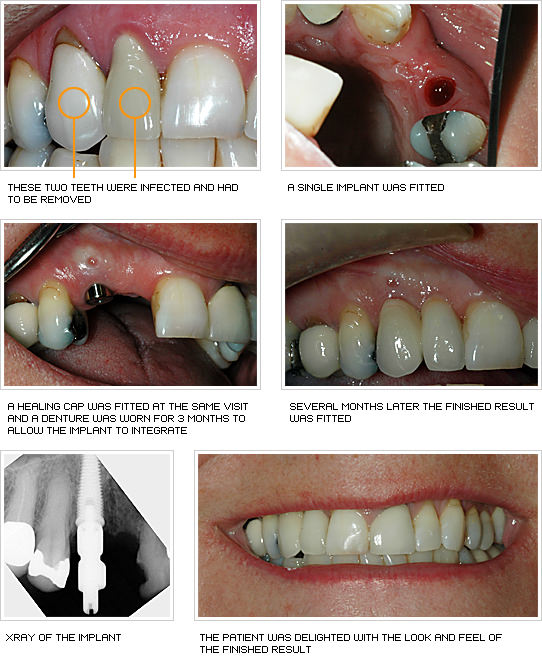Dental Sense Fundamentals Explained
Dental Sense Fundamentals Explained
Blog Article
Some Known Details About Dental Sense
Table of ContentsDental Sense for DummiesThe Greatest Guide To Dental SenseNot known Facts About Dental SenseThe 3-Minute Rule for Dental Sense
are medical devices operatively dental implanted right into the jaw to bring back a person's capability to chew or their look. They provide assistance for man-made (fake) teeth, such as crowns, bridges, or dentures. When a tooth is lost as a result of injury or illness, a person can experience issues such as fast bone loss, defective speech, or adjustments to eating patterns that result in pain.Oral implant systems are composed of a dental implant body and oral implant abutment and might also consist of a joint fixation screw. Root canal procedure. The dental implant body is operatively inserted in the jawbone in location of the tooth's origin. The dental implant joint is usually affixed to the dental implant body by the joint fixation screw and expands through gum tissues into the mouth to sustain the affixed fabricated teeth
(https://www.find-us-here.com/businesses/Dental-Sense-Miami-Florida-USA/34200016/)Structure of The Dental Implant System choosing oral implants, talk with your dental company regarding the prospective advantages and threats, and whether you are a candidate for the procedure. Points to consider: Your total wellness is a vital consider establishing whether you are a great candidate for oral implants, for how long it will certainly take to heal, and just how long the implant might remain in place.
Smoking cigarettes might affect the recovery procedure and reduce the long-term success of the dental implant. The healing procedure for the dental implant body may take a number of months or longer, during which time you usually have a momentary joint instead of the tooth. the oral implant procedure: Thoroughly adhere to the oral hygiene directions offered to you by your oral company.
How Dental Sense can Save You Time, Stress, and Money.
Implant failing can lead to the demand for another operation to deal with or replace the implant system. Recovers the capacity to chew Recovers cosmetic look Assists keep the jawbone from diminishing as a result of bone loss Preserves the wellness of the bordering bone and gum tissues Helps keep nearby (neighboring) teeth secure Improves quality of life Damage to bordering all-natural teeth throughout dental implant placement Injury to the surrounding tissues throughout surgery, such as sinus perforation Injury throughout surgical procedure (for instance, crack of surrounding jawbone) Insufficient feature, such as really feeling like the teeth do not attack together usually A sensation that the tooth hangs or twisting in location resulting from a joint screw loosening up Implant body failing (looseness of the implant body) due to systemic infection, which may be most likely in people with unchecked diabetes as a result of local infection in bone and gums sustaining the dental implant body due to postponed healing, which may be more probable in individuals that smoke Trouble cleansing the gum tissues around the dental implant, leading to poor dental hygiene Untreated periodontal condition Post-surgical feeling numb due to nerve impingement or damages Constantly alert healthcare suppliers and imaging technicians that you have oral implants before any kind of magnetic resonance imaging (MRI) or x-ray procedures.
FDA is not aware of any kind of negative events reported for MRI or x-ray treatments with oral implants. Dental implants systems are commonly constructed from products that adhere to worldwide consensus criteria of the International Organization for Standardization (ISO) or ASTM International. These standards have information of what makes a safe material.

A dental implant is a structure that replaces a missing out on tooth. With screw-like tools, the surgeon inserts an implant into the jawbone, and it acts as a support for a fabricated tooth, called a crown. A tool called a joint attaches the synthetic tooth to the dental implant. The crown is customized to fit the more person's mouth and match the shade of their teeth.
See This Report on Dental Sense
Some individuals are not qualified for dental implant surgical procedure. It is for oral cosmetic surgeons to operate individuals with: intense illnessuncontrollable metabolic diseasebone or soft tissue disease or infectionIf these problems are dealt with, an individual can have the surgical treatment. In, dental doctors avoid operating on individuals with: If people with any of the above undergo oral implant surgical treatment, there is a higher risk of the dental implant failing.

Oral implant surgical treatment is a personalized procedure. It's not the very same for everybody. The complying with provides a general overview of what you can expect your dentist, dental cosmetic surgeon, periodontist or prosthodontist to do: Put the dental implant operatively. Provide you time to recover. Affix the post and final crown, bridge or denture.
Next off, your doctor will meticulously position the oral implant into your jaw. Ultimately, your specialist will reposition your periodontals and shut the laceration with stitches. If your implant is near the front of your mouth, your dental practitioner will make a momentary tooth for you to wear until you recover. By doing this, you will not have a space in your smile while you recuperate.
Some Ideas on Dental Sense You Need To Know
During the healing stage, your jawbone should fuse to the oral implant. This process can take anywhere from 3 to nine months.
Once your dental implant heals, your dental practitioner can affix the abutment (small adapter message) and your last repair (crown, bridge or denture). This generally takes about one hour to complete and might call for a 2nd minor surgical procedure. You should not feel any kind of discomfort throughout your dental implant procedure due to the fact that your supplier will certainly utilize medication to numb your gums.
Report this page